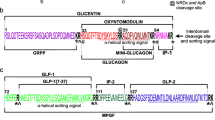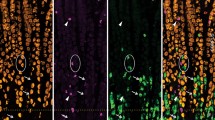Summary
In endocrine cells of the colon of adults, children and fetuses, exocytotic granule release without any specific stimulation is reported. Omega-invaginations are observed on both the lateral and basal surfaces of all types of colonic endocrine cells. Several explanations for the phenomenon are suggested: 1) emiocytosis is probably more frequent in the colon than in the proximal gut, this allows its observation without requiring an exogenous stimulus, 2) since most of the exocytotic figures are from anaesthetized subjects it is also assumed that contraction of the muscular layer induced by anaesthetics and the resulting increase in intraluminal pressure were the possible causes of granule release, 3) in non-anaesthetized subjects release may have taken place in response to a normal endogenous physiological stimulus, or to the dilation of colon during colonoscopy. Less likely is an effect associated with the preparation for colonoscopy. Certain figures on lateral surfaces between endocrine and adjacent cells i.e., bulges of parallel plasma membranes surrounding a secretory granule, were observed. Their significance is unknown.
Similar content being viewed by others
References
Cristina, M.L., Lehy, T., Zeitoun, P., Dufougeray, F.: Fine structural classification and comparative distribution of endocrine cells in the normal human large intestine. Gastroenterology 75, 20–28 (1978a)
Cristina, M.L., Lehy, T., Voillemot, N., Arhan, P., Pellerin, D., Bonfils, S.: Endocrine cells of the colon in Hirschprung's and control children. Virchows Arch. A Path. Anat. and Histol. 377, 287–300 (1978b)
Cristina, M.L., Lehy, T., Peranzi, G.: Etude ultrastructurale des cellules endocrines dans le colon humain foetal. Ontogénèse et distribution. Gastroenterol. Clin. Biol. 2, 1011–1023 (1978c)
Douglas, W.W., Nagasawa, J., Schulz, R.A.: Electron microscopic studies on the mechanism of secretion of posterior pituitary hormones and significance of microvesicles (“synaptic vesicles”); evidence of secretion by exocytotis and formation of microvesicles as a by-product of this process. Mem. Soc. Endocrinol. 19, 353–378 (1971)
Forssmann, W.G., Orci, L.: Ultrastructure and secretory cycle of the gastrin-producing cell. Z. Zellforsch. 101, 419–432 (1969)
Fujita, T., Kobayashi, S.: Experimentally induced granule release in the endocrine cells of dog pyloric antrum. Z. Zellforsch. 116, 52–60 (1971)
Fujita, T., Kobayashi, S.: The cells and hormones of the GEP endocrine system. The current of studies. In: Gastro-entero-pancreatic endocrine system, T. Fujita (ed.), pp. 1–16. Tokyo: Igaku Shoin 1973
Fujita, T., Osaka, M., Yanatori, Y.: Granule release of enterochromaffin (EC) cells by cholera enterotoxin in the rabbit. Arch. Histol. Jap. 36, 367–378 (1974)
Kobayashi, S., Fujita, T.: Emiocytotic granule release in the basal-granulated cells of the dog induced by intra-luminal application of adequate stimuli. In: Gastro-entero-pancreatic endocrine system. T. Fujita (ed.), pp. 49–58. Tokyo: Igaku Shoin 1973
Kobayashi, S., Sasagawa, T.: Morphological aspects of the secretion of gastro-enteric hormones. In: Endocrine gut and pancreas, T. Fujita (ed.), pp. 255–271. Amsterdam: Elsevier Scientific publishing Company 1976
Lacy, P.E.: Endocrine secretory mechanisms. Am. J. Pathol. 79, 170–187 (1975)
Lawson, D., Raff, M.D., Gomperts, B., Fewtrell, C., Gilula, N.B.: Molecular events during membrane fusion. A study of exocytosis in rat peritoneal mast cells. J. Cell Biol. 72, 242–259 (1977)
Miyagami, H., Watanabe, Y., Sawada, Y., Kato, K., Shiono, K., Kondo, K., Kidokoro, T.: Ultrastructures of G cells and the mechanism of gastrin release before and after selective vagotomy with pyloroplasty. Arch. Histol. Jap. 40, 51–62 (1977)
Nagasawa, J.: Exocytosis: the common release mechanism of secretory granules in glandular cells, neurosecretory cells, neurons and paraneurons. Arch. Histol. Jap. 40, 31–47 (1977)
Normann, T.L.: Neurosecretion by exocytosis. Int. Rev. Cytol. 46, 1–77 (1976)
Orci, L., Amherdt, M., Malaisse-Lagae, F., Rouiller, Ch., Renold, A.E.: Insulin release by emiocytosis: a demonstration with freeze-etching technique. Science 179, 82–84 (1973)
Orci, L., Perrelet, A.: Islet cell membrane perturbation during exocytosis. In: Endocrine gut and pancreas, T. Fujita (ed.), pp. 295–299. Amsterdam: Elsevier Scientific publishing Company 1976
Osaka, M., Sasagawa, T., Fujita, T.: Granule release from endocrine cells in acidified human duodenal bulb: an electron microscope study of biopsy materials. Arch. Histol. Jap. 37, 73–94 (1974)
Author information
Authors and Affiliations
Rights and permissions
About this article
Cite this article
Cristina, M.L., Lehy, T. Emiocytotic granule release without intraluminal stimulus in human colonic endocrine cells of fetuses, children and adults. Virchows Arch. A Path. Anat. and Histol. 382, 283–291 (1979). https://doi.org/10.1007/BF00430404
Received:
Issue Date:
DOI: https://doi.org/10.1007/BF00430404




